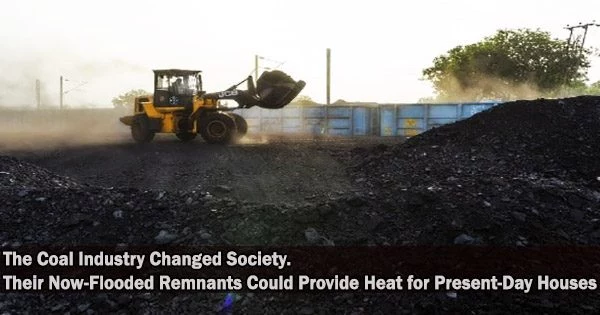The Industrial Revolution, which had its beginnings in Britain in the 18th century, had far-reaching effects.
This historical turning point was made possible in large part by the abundance and accessibility of coal in Britain, which powered the steam engines that sped up social change.
But things have changed. Since authorities announced in June that Britain would stop using coal to generate power in October 2024, a year earlier than the planned goal of 2025, the number of active coal mines there has plummeted.
Even if the majority of mines in the United Kingdom have shut down, their lengthy history isn’t necessarily over. In Scotland, research is being done to determine how ancient, abandoned mines’ floodwaters may be used to decarbonize heat buildings.
The Glasgow Geoenergy Observatory, a facility run by the British Geological Survey, is where this study is being done. There have been 12 boreholes dug, the majority of which are in Rutherglen, a town southeast of Glasgow.
Some of the busiest coal mines in Scotland were located in Rutherglen and Glasgow, according to those in charge of the project. Natural floods flooded them with water that was about 12 degrees Celsius after they were closed.
Mike Stephenson, who was until recently executive chief scientist for decarbonization at the British Geological Survey, told CNBC that the project was about “doing research on the heat in coal mines and also, to some extent, whether you can store heat in old coal mines.”
Stephenson said that at the site where the work is taking place, the team was “experimenting with … how fast water flows amongst these mines, how warm the water is, how … fast, if you take warm water out, does the water replenish so how fast does the warmth come back.”
“It is a research site, not a demonstration,” he said. Research was being undertaken “to try and understand what are the limits to the amount of heat, how much heat there is.”
“All those things will be a set of scientific findings and equations and models,” he added. He said this would provide valuable information to both companies and local authorities interested in the idea.
“It will help them decide where to do it, how close you drill the holes together, how deep you drill them, how you design them to make it as efficient as possible.”
The project has made progress over the last 12 months or so. The completion of pumping tests and sample collection from 10 of the site’s boreholes were announced in the summer of 2021.
“The latest data show that the boreholes of the Glasgow Observatory are well-connected to the flooded mine workings,” Alan MacDonald, a hydrogeologist with the British Geological Survey, said at the time.
Mine water between 50 and 90 meters under Glasgow measures between 11 and 13 degrees Celsius, he added. For comparison, the average temperature of Scottish groundwater is 10 degrees, MacDonald said.
Potential uses
According to Britain’s Coal Authority, 25% of the U.K.’s residential properties sit on coalfields. Underground, flooded mines, like those being studied in Glasgow, have the potential to be significant sources of heating.
Citing its own calculations, the Coal Authority says the “constantly replenishing water within these mines could potentially be a large enough resource to provide all of the heating requirements for the coalfield areas.” It could also have applications in sectors such as manufacturing and horticulture.
“The water in these mines is a low carbon, sustainable heat source, which under the right conditions can compete with public supply gas prices and deliver carbon savings up to 75% compared to gas heating,” it notes.
Although several governments are making efforts to do away with coal, it still has a significant impact on many countries. A third of the world’s electricity is produced by coal, according to the International Energy Agency.
The Paris-based agency predicted in December that coal-fired electricity generation will reach an all-time high in 2021. As for coal production, the IEA said it’s “forecast to reach an all-time high in 2022 and then plateau as demand flattens.”
Although coal remains a significant source of electricity and was essential to the world’s industrialization, it has a significant impact on the environment.
The U.S. Energy Information Administration lists a range of emissions from coal combustion. These include carbon dioxide, sulfur dioxide, particulates and nitrogen oxides.
Elsewhere, Greenpeace has described coal as “the dirtiest, most polluting way of producing energy.”
In the northeast of England, South Tyneside Council has been working on a project aiming to repurpose part of the area’s mining heritage.
According to the council, the £7.7 million ($10.4 million) Hebburn Minewater Project will “draw geothermal energy from abandoned flooded mines in the former Hebburn Colliery.”
The initiative aims to supply heat to several buildings that the council owns by using mine water from the old colliery, which opened in the late 18th century and shut down in 1932.
The project is centered on the drilling of two boreholes. A water source heat pump will extract the mine water’s heat, after which it will be compressed to a far greater temperature. After being funneled to an energy center, a new network of pipes will be used for distribution.
The council is working on the project, which is slated for completion in June 2023, alongside Durham University and the Coal Authority. Last October, it was announced that testing had shown the mine water’s temperature was warmer than initially thought.
New lease of life
Attempts to use the warm waters of flooded mines are not unique to the U.K. The first mine water power station in the world opened in the Netherlands in 2008, according to the European Commission. In Asturias, in northern Spain, a similar concept based on using mine water to heat houses has also been created.
Back in South Tyneside councilor Ernest Gibson, whose brief covers climate change, spoke to CNBC about the industry’s deep-rooted relationship with the area and his hopes for the future.
“The economics of the area declined as soon as the coal mines closed,” Gibson, a former miner, said.
He explained how the shutting down of a colliery affected not only the mining industry but also others like the steel and transport industries, as well as smaller operations like local shops and the “ragman,” a term for a person who would buy, collect and sell old items.
Gibson went on to tell CNBC that he’s “proud” of the fact old coal mines are being used again.
“The collieries closed but … they were revived in a different format,” he said, later striking a more philosophical tone. “It’s like life everything changes, nothing stands still. And I think it’s for the best.”















